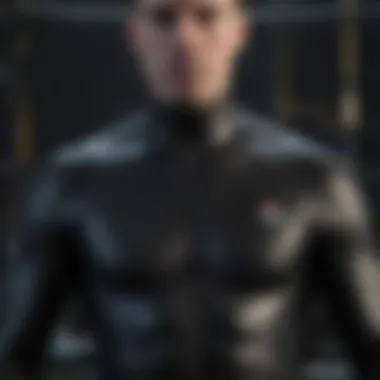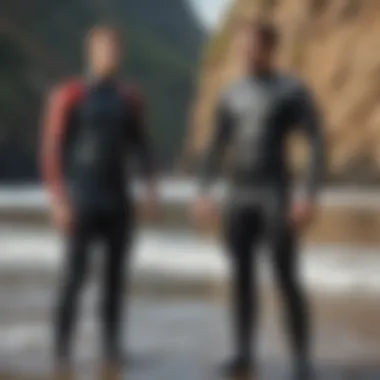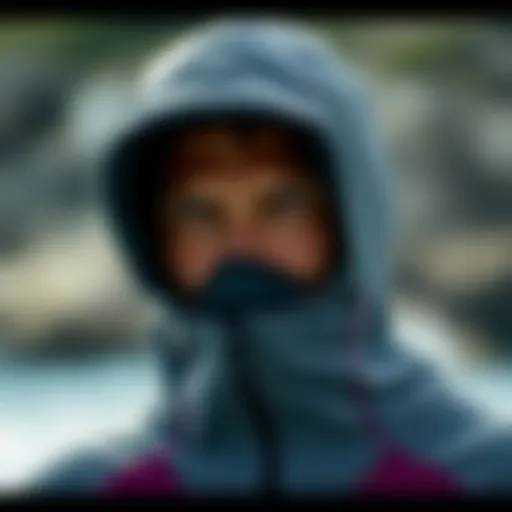Exploring the Benefits of Zipperless Wetsuits


Intro
In an era where performance and comfort dictate the quality of outdoor sports equipment, the zipperless wetsuit emerges as a remarkable alternative to traditional wetsuits. For kiteboarders, who often engage in both the thrill of the ride and the tranquility of water, this innovation offers a tailored experience that combines flexibility with insulation. This exploration will unpack the distinctive design elements, advantages, and overall suitability for kiteboarding enthusiasts.
Going beyond the mere absence of a zipper, the zipperless wetsuit presents unique material innovations that potentially enhance not just comfort but also versatility in various water conditions. It’s not just a fashion statement in the kiteboarding world, but an integral part of enhancing one’s performance on the water.
By the time we’ve navigated through the essential details, including gear insights and practical tips, kiteboarders will have a clearer understanding of how a zipperless wetsuit can transform their time on the water — offering not just warmth, but a seamless experience that traditional options may lack.
Preamble to Zipperless Wetsuits
When it comes to engaging in water sports like kiteboarding, comfort and movement are key factors that can make or break an experience. This is where the concept of zipperless wetsuits comes in. Unlike traditional wetsuits with zippers, which can create pressure points and restrict movement, zipperless versions offer an alternative that promises enhanced flexibility and an improved fit. This section will walk you through the essence of zipperless wetsuits and why they are garnering attention in the kiteboarding community.
Understanding the Concept
Zipperless wetsuits are designed to embrace the body without the added bulk of zippers. They often use stretchy materials that hug the skin, creating a second-skin sensation. The absence of a zipper means that water has a harder time seeping in, resulting in a warmer experience during those chilly kiteboarding sessions. By adopting various closure systems, such as tight-fitting necklines or adjustable straps, these wetsuits aim to provide the same degree of insulation and comfort as their zippered counterparts.
One of the fascinating aspects of zipperless wetsuits is their ergonomics. Without a zipper to deal with, these suits often feature seamless designs that allow for greater freedom of movement. This can have a substantial impact on one’s performance in the water, particularly in sports requiring agility, like kiteboarding. Riders frequently share that they feel more connected to their boards and the water itself, akin to feeling both weightless and powerful.
Historical Context of Wetsuit Development
To understand the emergence of the zipperless wetsuit, it's crucial to take a step back and explore the evolution of wetsuit technology. The first wetsuits were introduced in the 1950s, primarily made from neoprene, which offered insulation while also being buoyant. As water sports gained in popularity, suits evolved, introducing zippers to make them easier to wear.
For years, these designs were viewed as the standard. However, with advancements in material science, the limitations of zippers began to surface. There were complaints concerning discomfort and water ingress at the zipper sites. This led to a quest for innovation, where manufacturers started experimenting with new materials and construction techniques. Over time, the idea of a zipperless suit took shape, leading to the creation of modern wetsuits that prioritize comfort, movement, and minimal water intrusion.
Today, the zipperless wetsuit stands as a testament to the industry's ability to adapt and respond to the needs of water sports enthusiasts. They are not just the latest trend but a significant step forward in wetsuit technology, demonstrating how gear can evolve alongside its users.
"The absence of a zipper highlights the innovation behind this design, showcasing a commitment to rider comfort and performance that resonates with modern kiteboarders."
Overall, the introduction of zipperless wetsuits is not merely a change in design; it's a reflection of changing priorities in water sports equipment. As more kiteboarders, instructors, and thrill-seekers turn to this style of wetsuit, further innovations are likely to follow, all aiming to enrich the riding experience.
Design Features of Zipperless Wetsuits
Understanding the design features of zipperless wetsuits is essential for anyone engaged in aquatic sports, particularly kiteboarding. The absence of a zipper marks a significant shift in wetsuit design, influencing comfort, performance, and usability. In the world of kiteboarding, where movement and flexibility are paramount, each design element plays a crucial role in the user’s overall experience.
Material Innovations
Neoprene Variations
At the heart of zipperless wetsuit technology lies neoprene, with its variations pushing the boundaries of traditional wetsuit performance. Modern neoprene blends come equipped with unique characteristics, enhancing elasticity and insulation. One of the most notable variations is limestone-based neoprene, often hailed for its eco-friendliness and superior durability. This type of neoprene not only offers better insulation but also boasts impressive stretchability, allowing the wetsuit to move seamlessly with the body.
Another interesting aspect of neoprene variations is the introduction of biodegradable options. These innovations aim to reduce environmental impact, appealing to conscious consumers who prioritize sustainability in their gear choices. Although these options often carry a higher price tag, the long-term benefits for the planet make them worth considering.
Seam Construction
The construction of seams in zipperless wetsuits is another pivotal factor that greatly influences performance. Advanced seam techniques like flatlock stitching and blind stitch construction contribute to the overall strength and water resistance of the suit. These methods create a seamless appearance while ensuring that water has minimal opportunity to seep in.
One unique feature of these seams is the use of waterproof taping. This innovation adds an extra layer of protection against water ingress, making the suit ideal for varied water temperatures and conditions. However, it’s worth noting that while these seams enhance durability, they may require specialized care during cleaning to maintain integrity.
Fit and Comfort
Anatomical Design
The anatomical design of zipperless wetsuits is tailored for enhanced comfort and support. Unlike traditional wetsuits, which can cause discomfort due to zipper placement, these suits offer a streamlined fit. They contour closely to the body, promoting an unrestricted range of motion. This close fit is incredibly beneficial in kiteboarding, where every movement counts.
Additionally, the absence of a zipper means there are fewer pressure points, making long sessions on the water vastly more enjoyable. Users often comment on how much easier it is to find a comfortable position without the restrictive nature of a zipper constraining their movement.
Thermal Regulation


When discussing thermal regulation, zipperless wetsuits shine thanks to their innovative thermal lining. Advanced materials designed to trap body heat while allowing moisture to escape are increasingly common. This helps maintain the body’s core temperature during intense activities.
A standout feature of thermal regulation in these suits is their impressive quick-drying capabilities. While traditional wetsuits often retain moisture, increasing weight and drag, the new designs thwart that issue effectively. This characteristic not only enhances comfort but also boosts performance, as kiteboarders can focus solely on their skills rather than adjusting and battling discomfort.
"The design without a zipper allows a more snug fit, which is felt immediately in both warmth and flexibility."
Advantages of Zipperless Wetsuits
The advent of zipperless wetsuits marks a significant shift in the realm of water sports gear, particularly for kiteboarding. While traditional wetsuits have been king for years, the innovations found in zipperless designs present several compelling advantages that cater to both performance and comfort. For kiteboarders, these benefits can be the difference between a thrilling ride and an uncomfortable struggle against the elements. Let’s delve into the specifics of what makes these suits stand out.
Increased Flexibility
One of the most praised qualities of zipperless wetsuits is their ability to offer increased flexibility. Unlike zipped alternatives, which can become constrictive around the chest and shoulders, these suits are designed to contour your body more naturally. This allows for a greater range of motion during maneuvers which is crucial for kiteboarding.
Instead of feeling locked in, wearers often describe the sensation akin to being wrapped in a second skin. The materials used, such as advanced neoprene blends, enhance this flexibility, offering both stretch and support. For someone navigating strong winds and choppy waters, having unrestricted movement can lead to improved skill execution, whether going for those high-flying tricks or quick directional changes.
"Wearing a zipperless wetsuit feels like my body can really move. No awkward pulling, just pure freedom in the water."
– Jenna Pavlov, experienced kiteboarder
Reduced Water Ingress
Water ingress is a common frustration for many kiteboarders, especially when cutting through waves. Zipperless wetsuits generally feature a more streamlined design, which significantly reduces the chances of water sneaking in. The absence of a zipper means there are fewer gaps where cold water can invade, maintaining warmth and comfort.
Additionally, many of these suits come equipped with specialized seals and cuffs made from high-quality materials which snugly fit against the body. This not only keeps you warm, but also enhances buoyancy and keeps you feeling planted on your board. Kiteboarding can involve feisty splashes; thus, minimizing water entry means longer, more enjoyable sessions without the disruption of a cold surprise inside your suit.
Quick Donning and Doffing
For those who prefer to keep their kiteboarding sessions seamless, the ability to quickly put on or take off gear is crucial, making quick donning and doffing a sought-after quality of zipperless wetsuits. Many who kiteboard know that time is of the essence, especially when the wind is just right.
Instead of wrestling with zippers, which can sometimes jam or require assistance, zipperless designs allow you to simply slide in and out. This practicality can be a game-changer, speeding up the process and allowing more time on the water. Particularly after a rigorous session, when your focus is on removing gear efficiently to grab a drink or discuss the last ride with friends, a seamless transition can help maintain the overall flow of the day.
In summary, the advantages of zipperless wetsuits are quite compelling for anyone looking to improve their kiteboarding experience. From enhanced flexibility and reduced water ingress to an easier on-and-off experience, these features resonate well with both competitive and recreational kiteboarders alike.
Performance Implications for Kiteboarding
When it comes to kiteboarding, the choice of wetsuit can significantly sway both performance and overall experience. The zipperless wetsuit, in particular, is not just a piece of gear; it's a game-changer for many riders on the water. This section will unpack the essential role that this innovative wetsuit plays in enhancing rider capabilities and comfort, factors that directly influence performance on the kiteboarding scene.
How Fit Affects Performance
The fit of a wetsuit is crucial. A proper fit helps maintain an optimal body shape while riding. Zipperless wetsuits are crafted to hug the body closely without being restrictive. When your wetsuit is tailored to your body, it allows for better control over the kite and board. The snug fit minimizes any billowing or excess material that could create drag.
A few things to note about fit include:
- Water Resistance: A well-fitted wetsuit keeps water from flushing through, ensuring you stay warm and nimble. This is vital, especially when you're trying to land difficult tricks or maintain balance during sharp turns.
- Mobility: A tight but flexible design ensures you're not battling your suit while you maneuver. The absence of zippers means fewer points of failure, enhancing your freedom of movement.
- Confidence: When you know your equipment fits perfectly, you gain a mental edge. You’re more likely to push your limits without worrying about whether your gear can keep up.
It’s clear that how a wetsuit fits changes how you ride, and zipperless wetsuits spotlight this aspect beautifully.
Impact on Movement and Skill Execution
Flexibility is king in kiteboarding, where subtle shifts in body position can mean the difference between a stunning aerial display and a watery mishap. Zipperless wetsuits enhance flexibility through their design, often relying on advanced material technology—think neoprene magic—that permits a full range of motion.
Here’s how this plays out in practice:
- Aerial Maneuvers: With greater freedom to move, kiteboarders can execute complex aerial tricks. Jumps, spins, and flips require unwavering balance and control, and a zipperless wetsuit allows for those last-minute adjustments.
- Quick Adjustments: Kiteboarding isn’t just about the tricks; it’s also about responding to wind changes. The ability to pivot quickly and adjust your stance without feeling hindered by your gear leads to better decision-making on the fly.
- Skill Refinement: For those honing their skills, the suit’s snug nature promotes better body awareness. Practicing new moves becomes more intuitive when you feel every muscle engaged without the constraint of bulky zippers.
An adept rider once said, "In kiteboarding, your connection to the board is as critical as your connection to the kite. A great wetsuit solidifies that bond."
In summary, performance in kiteboarding is intricately tied to the gear you choose. Zipperless wetsuits offer unparalleled flexibility and fit, inviting riders to explore their full potential on the water. Whether you're a seasoned pro or simply enjoying a weekend ride, these features cannot be overlooked. As the sport continues to evolve, choosing the right wetsuit becomes not just a matter of comfort, but a pivotal element of performance.
Disadvantages and Considerations


When venturing into the world of zipperless wetsuits, it's crucial to explore not only the benefits but also the potential downsides that come along with this innovative approach. Although many kiteboarders are drawn to the advantages such as flexibility and ease of use, there are specific factors that need careful consideration before making a purchase. For enthusiasts, instructors, and even casual users, understanding these disadvantages can greatly influence gear selection and performance on the water.
Limited Temperature Range
A primary concern with zipperless wetsuits is their limited temperature range. Traditional wetsuits often come with zippers that allow users to regulate their body temperature more effectively by increasing or decreasing water flow in and out. With a zipperless design, once you're in, it's tough to let out that extra heat unless you completely remove the suit.
This can be problematic in varying water temperatures.
- Warm Water: In warm conditions, the snug fit can become quite stifling if the suit does not allow for any air circulation.
- Cooler Temperatures: Conversely, wearing a zipperless wetsuit in cold water could lead to quick heat loss, as the suit needs to maintain a close fit to minimize water entry. The insulation provided by neoprene may not be sufficient if the suit becomes too saturated.
Therefore, it’s vital for kiteboarders to assess where and when they plan to ride. A zipperless wetsuit might suit a steady climate, but in areas with significant temperature fluctuations, an adjustable suit might be the smarter choice.
Repair and Maintenance Challenges
Repairing and maintaining a zipperless wetsuit presents its own set of challenges. The absence of a zipper simplifies one element but complicates others. Here’s what to keep in mind:
- Material Integrity: Given that these wetsuits are typically made from high-quality neoprene, any punctures or tears can jeopardize the entire suit’s performance. Unlike zippers which can be replaced, damaged areas in a zipperless design often require patching or specialized repairs. This can lead to costly repairs if it happens frequently.
- Cleaning and Drying: Zipperless suits often have seams that require special attention. Because they are designed to minimize water ingress, improper cleaning or drying could result in mildew or odors, making careful maintenance an ongoing task.
- Longevity: When a zipper malfunctions, swapping out one component can extend a wetsuit's lifespan. However, if a zipperless suit starts showing its age, users might confront the dilemma of whether to invest in repairs or consider buying a new suit altogether.
"It's essential to balance the convenience of design against long-term maintenance needs and personal preferences. Be savvy about what suits your lifestyle best."
These disadvantages are not deal-breakers for everyone; yet, they warrant thoughtful consideration before purchasing. Choosing the right wetsuit is a personal decision based on climate, usage, and maintenance willingness. Understanding your own needs will ensure a better ride, preparation, and overall experience while kiteboarding.
Choosing the Right Zipperless Wetsuit
Selecting the right zipperless wetsuit can significantly impact your performance and enjoyment while kiteboarding. Given the alternatives available, a thoughtful approach to this decision-making process is crucial. The ideal suit complements not only your physique but also your style and frequency of use in the water. It’s a balance of comfort, functionality, and durability that can enhance your experience. Here, we’ll delve into key features that influence this choice, as well as offer comparisons among brands.
Key Features to Look For
Size and Fit
When it comes to sizing, there’s no room for guesswork. A well-fitting wetsuit should hug the body without feeling restrictive or causing discomfort. The right size affects overall performance; if a suit is too loose, you can experience water entry, which hinders thermal insulation and mobility.
One key characteristic of a good fit is the anatomical design. Features like articulated knees and shoulder panels can make a world of difference. The suit should allow for natural movement while still being snug enough to prevent water from seeping in. This snug feeling can seem daunting at first, but remember, it’s about functionality over fashion.
Another aspect to consider is ease of entry. Zipperless suits rely on the flexibility of the material for donning and doffing. Many designs prefer a body slide method or minimal openings at the ankles. This adds convenience yet mandates that the body shape aligns perfectly with the suit. Finding one that caters specifically to your body type ensures both comfort and performance in various activities.
Material Quality
The quality of the material influences not only comfort but also durability and longevity. Neoprene is the most common fabric used; however, variations exist which can affect flexibility and insulation. Some variations provide better thermal properties, while others boast stretch for maximum movement.
One notable aspect of material quality is the construction method. High-quality wetsuits often feature techniques like glued seams which help minimize water entry, contributing to warmth and comfort. It’s essential to choose a suit made from high-quality materials, as this will enhance your experience in colder waters. A suit that retains heat well will keep you in the water longer.
The trade-off here is often cost: higher quality materials come at a premium. However, investing in a suit that withstands wear and tear can pay off, especially if you’re a frequent kiteboarder. The result? Less time worrying about repairs and more time enjoying your time on the water.
Brand Comparisons
Not all wetsuits are created equal, and several brands stand out when it comes to zipperless designs. Each brand brings unique features, strengths, and weaknesses to the table. Brands like O’Neill, Rip Curl, and Xcel are noted for their top-notch innovations. They each offer various models catering to different preferences and price points.
- O’Neill: Known for its attention to detail and commitment to quality, O’Neill wetsuits often feature unique materials and flexible joints. Their designs appeal to serious athletes who prioritize movement.
- Rip Curl: This brand tends to focus on performance in various conditions, offering suits that excel in both cold and warmer waters. They emphasize eco-friendly materials, attracting environmentally conscious consumers.
- Xcel: They’re celebrated for cutting-edge technology, especially in thermal performance. Xcel wetsuits are highly rated for their insulation properties, making them great for colder climates.
It’s worth checking out user reviews and testimonials to gain insights into particular models. Many kiteboarders share their experiences on forums and social media, providing a collective knowledge base that can guide your decision. Visit Reddit or Facebook groups dedicated to kiteboarding for real-world advice from fellow enthusiasts.
"Ultimately, the choice of wetsuit should reflect your individual needs and preferences—there is no one-size-fits-all solution when it comes to water sports."
In summary, when looking to buy a zipperless wetsuit, consider size and fit along with the quality of materials. Research brands and read user experiences to find the perfect suit that complements your kiteboarding adventures.
User Experiences and Testimonials
Understanding the voices of those who use zipperless wetsuits—both recreational and competitive kiteboarders—provides a lens into the practicality and value of these innovative designs. These real-life accounts enrich the narrative around wetsuit technology, showcasing how these suits resonate in varied water conditions and usage scenarios. By integrating personal stories, we can uncover not just the technical merits of these wetsuits but also the emotional and experiential aspects that come with wearing them. This section dives into the unique anecdotes and assessments shared by riders to offer a well-rounded perspective on zipperless wetsuits.


Competitive Athletes
Competitive athletes often push the boundaries of what's possible in kiteboarding. Their gear needs to support their very best, and that includes the wetsuit they choose. Zipperless wetsuits have emerged as a favored choice among professionals for several reasons. For instance, the seamless design allows for enhanced freedom of movement, crucial during intense maneuvers and tricks. With no zipper restriction, athletes report that they experience greater range in their motions, especially when executing jumps and flips.
Moreover, many elite kiteboarders highlight the lower weight of zipperless models, making them feel less bulky while riding. Athletes like Danny Falker have mentioned that when competing, every ounce matters; lightweight gear lets them feel more agile on the water. Some have even gone so far as to say that the absence of a zipper made them feel like they have a second skin, blending seamlessly with the water.
"In competition, you don't just ride the board; you become one with it. A zipper can disrupt that connection," remarked professional kiteboarder Julia Voss.
The thermal efficiency of these wetsuits is also frequently praised. As competitive events often extend over long hours in variable weather, staying warm yet agile can be challenging. Many athletes appreciate how zipperless suits maintain core temperature, allowing them to focus on performance without the constant distraction of cold.
Recreational Kiteboarders
For the recreational kiteboarders, the experience with zipperless wetsuits tends to revolve around comfort and ease of use. Many adventurers who enjoy casual weekend outings appreciate how these wetsuits simplify the process of gearing up and getting into the water. The absence of a zipper means fewer struggles and quicker transitions, allowing them to spend more time enjoying the water.
One such enthusiast, Marco Santiago, shared his experience: "After a long week of work, the last thing I want to do is fight with a wetsuit. With the zipperless design, it feels much less like a chore getting into my gear, which is a big win after a tiring week."
Comfort also remains a primary focus for those in the recreational scene. Many have reported finding the fit of zipperless suits snug yet not constricting, providing a sense of security without the need for constant adjustments. The anatomical designs cater to movement, which is perfect for those maneuvering through waves and wind.
In terms of thermal regulation, recreational kiteboarders note a pleasant surprise: they find the materials used in zipperless wetsuits often keep them warm, without overheating during those sunny beach days. This balance is crucial for a day spent on the water, offering them the versatility to enjoy warm afternoons without discomfort.
In summary, whether through the lens of pros or casual riders, the feedback on zipperless wetsuits emphasizes their functionality and comfort. User experiences convey a consistent message: these suits shine in enhancing the kiteboarding experience, whether for competitive pursuits or enjoyable leisure.
Future Trends in Wetsuit Technology
As the world of water sports evolves, so too does the technology behind the gear we use, particularly wetsuits. The importance of keeping abreast of future trends in wetsuit technology is paramount for kiteboarders and other water enthusiasts. Innovations not only enhance performance and comfort but can also lead to increased safety and sustainability in the sport. In this section, we’ll delve into two crucial areas: emerging materials and techniques, and the sustainability of wetsuit manufacturing.
Emerging Materials and Techniques
Wetsuit technology is on the brink of a revolution, primarily spurred by advancements in materials. Traditional neoprene has set the standard, yet innovators are now exploring alternatives that promise to deliver better performance. One example is the development of Yulex, a natural rubber sourced from the guayule plant. This not only offers excellent thermal properties but also reduces dependency on petroleum.
Furthermore, companies are experimenting with closed-cell foam structures that enhance buoyancy while maintaining flexibility. This kind of material helps kiteboarders stay afloat longer without sacrificing movement, a critical aspect for performance on the water.
In addition, new bonding techniques are being introduced that reduce the need for stitching, a common area where water can seep in. These advancements lead to seamless designs, which significantly contribute to a more comfortable and watertight fit.
"The push towards lighter, more flexible materials can lead to a quantum leap in how athletes experience performance and comfort while kiteboarding."
Sustainability in Wetsuit Manufacturing
With rising awareness of environmental issues, sustainability in wetsuit manufacturing is gaining traction. Traditional wetsuit production is often criticized for its heavy environmental footprint, given the use of synthetic materials and toxic chemicals. Manufacturers now face the challenge of not only improving their product but doing so in a manner that meets ecological standards.
One way brands are addressing these concerns is by utilizing recycled materials. For instance, some companies have started incorporating recycled plastics into their wetsuit production. This repurposing of materials provides a viable path to reducing waste and minimizing the harvesting of new resources.
Moreover, sustainable production processes are being adopted. This includes reducing water consumption and employing eco-friendly dyes that do not introduce harmful substances to waterways. By embracing these techniques, brands are not only helping the environment but also appealing to a growing consumer base that prioritizes sustainable choices.
Ending and Recommendations
In the realm of water sports, particularly kiteboarding, choosing the right gear isn’t just about comfort; it’s about performance, safety, and overall enjoyment. Zipperless wetsuits have emerged as a formidable option for many enthusiasts, offering unique advantages that traditional wetsuits often cannot match. This section not only wraps up the discussion presented in this article but also provides valuable recommendations that cater specifically to kiteboarders, instructors, and adventurers alike.
When considering a zipperless wetsuit, it’s important to recognize several crucial elements:
- Fit Matters: A snug yet comfortable fit enhances mobility. Ensure the wetsuit contours to your body shape, as this will greatly affect your freedom of movement on the water.
- Material Quality: Opt for high-grade materials like limestone neoprene, which provides flexibility and warmth. A well-constructed wetsuit can make all the difference.
- Temperature Regulation: Given that kiteboarding often occurs in varying weather conditions, a suit with good thermal regulation will keep you both warm and agile.
- Durability: Pay attention to seam construction. Glued and blind-stitched seams often provide better durability compared to regular stitched seams.
- Eco-friendliness: With growing concerns about marine conservation, looking for brands that adopt sustainable practices in their manufacturing can go a long way.
"Selecting the right wetsuit can drastically elevate your kiteboarding experience. A mismatch may lead to discomfort or hinder your performance."
Summarizing the Key Takeaways
To reinforce the primary insights from our discussion:
- Design Flexibility: Zipperless wetsuits excel in flexibility and comfort, allowing for a more natural range of motion.
- Reduced Water Entry: These suits offer a snug fit that minimizes water ingress, providing better insulation.
- Easy to Wear: Quick donning and doffing are essential for convenience, especially when conditions change swiftly.
- Performance: Kiteboarders reported improved mobility and reduced drag with zipperless designs, positively impacting their skills on the water.
- Considerations: While beneficial, they may not be suitable for all temperature ranges, and maintenance can be more challenging compared to traditional options.
Final Thoughts on Zipperless Wetsuits in Kiteboarding
In navigating the continual evolution of kiteboarding gear, zipperless wetsuits represent an exciting frontier. Their growing popularity is a testament to advances in material science and design thinking that cater to the aquatic athlete’s needs. Adopting these suits means embracing a technology that prioritizes comfort and performance while advocating for sustainability.
As the kiteboarding community embraces more innovative solutions, the zipperless wetsuit stands out as a compelling alternative, combining comfort with enhanced versatility. The right choice in gear greatly influences your kiteboarding experience, making it worthwhile to consider thoughtful recommendations laid out in this article. So, whether you’re a seasoned competitor or a weekend warrior, finding the ideal zipperless wetsuit could be the key to unlocking your full potential on the waves.















